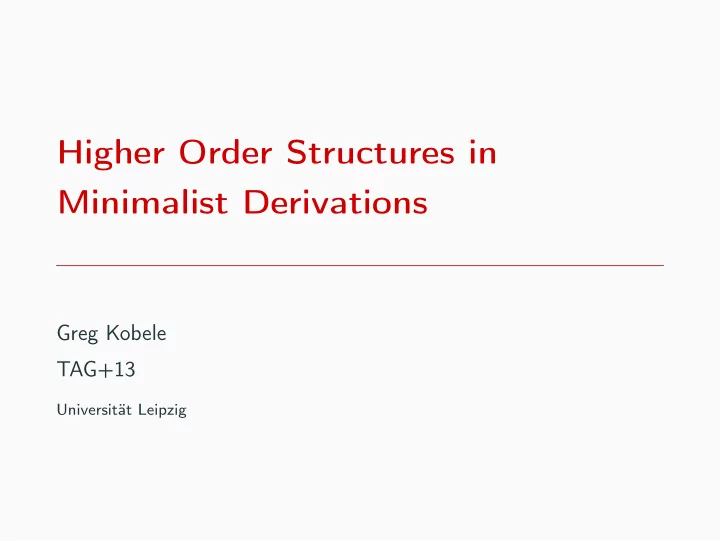

Local trees this exploits: MG derivation trees form a local set move merge v ; -k =v . +k . s 22
Local trees this exploits: MG derivation trees form a local set move merge merge =v . +k . s =d . v d . -k 22
Local trees this exploits: MG derivation trees form a local set move merge merge =v . +k . s merge =d . v =n . d . -k n 22
Local trees this exploits: MG derivation trees form a local set move merge merge =v . +k . s merge =d . v every n 22
Local trees this exploits: MG derivation trees form a local set move merge merge =v . +k . s merge =d . v every boy 22
Local trees this exploits: MG derivation trees form a local set move merge merge will merge =d . v every boy 22
Local trees this exploits: MG derivation trees form a local set move merge merge will merge laugh every boy 22
Undoing movement • When we hypothesize a move node: move +k . s ; -k 23
Undoing movement • When we hypothesize a move node: move +k . s ; -k • We next must hypothesize where the mover is: move merge merge � d . -k � 23
Appearances can be deceiving Every boy will (seem to) ∗ laugh move move move merge merge merge � � � merge merge merge � d . -k � � merge merge � � merge merge � d . -k � merge � merge � d . -k 24
If only . . . move merge � � merge d . -k � 25
If only . . . move merge � � merge d . -k � • Might work in this case, • but is there a non-analysis specific principle? 25
Structure in derivations MG derivations are subregular (Graf) (Tier-based) strictly local strict locality conjunction of negative literals (with immediate successor) tier-based relativized successors ( ⊳ T , where T ⊆ Σ ) 26
Example (strings) Primary stress ⊳ := ⊳ ´ σ Have primary stress ¬ ($ ⊳ $) Have at most one stress ¬ (´ σ ⊳ ´ σ ) 27
Example (trees) Movement (Graf) ⊳ := ⊳ + k , - k Movers gonna move ¬ ($ ⊳ ℓ ) No movement without movement ¬ ( move ⊳ $) No competition ¬ ( move ⊳ ℓ 1 , ℓ 2 ) 28
Argument structure via n -grams Every lexical item ℓ appears in a derivation with a unique local context • depends exclusively on positive feature sequence ( =x and +y ) ( will , =v . +k . s ) 29
Argument structure via n -grams Every lexical item ℓ appears in a derivation with a unique local context • depends exclusively on positive feature sequence ( =x and +y ) merge ( will , =v . +k . s ) � 29
Argument structure via n -grams Every lexical item ℓ appears in a derivation with a unique local context • depends exclusively on positive feature sequence ( =x and +y ) move merge ( will , =v . +k . s ) � 29
Exploiting regularities in derivations • When we hypothesize a move node: move +k . s ; -k 30
Exploiting regularities in derivations • When we hypothesize a move node: move +k . s ; -k • We know it immediately dominates a mover (on the relevant tier): move +k . s d . -k 30
A sketch � 31
A sketch move � 31
A sketch move merge � � 31
A sketch move merge every � 31
A sketch move merge every boy 31
A sketch move merge � merge every boy 31
A sketch move merge will merge every boy 31
A sketch move merge merge will � merge every boy 31
A sketch move merge merge will laugh merge every boy 31
A sketch move merge merge will merge laugh every boy 31
A basic ’hole’ data structure α g xs • g is a gorn address where we are in the derived tree data Hole t b x = Hole t [(b,x)] 32
A basic ’hole’ data structure α g xs • g is a gorn address where we are in the derived tree • xs is a (finite) list of data Hole t b x = Hole t [(b,x)] 32
A basic ’hole’ data structure α g xs • g is a gorn address where we are in the derived tree • xs is a (finite) list of • derivations with holes elements in separate tiers data Hole t b x = Hole t [(b,x)] 32
A basic ’hole’ data structure α g xs • g is a gorn address where we are in the derived tree • xs is a (finite) list of • derivations with holes elements in separate tiers • . . . paired with feature bundles information about the occupied tier data Hole t b x = Hole t [(b,x)] 32
Unmerge1 • Given α : g xs 33
Unmerge1 • Given α : g xs • merge could have applied merge =x .α : g 0 x : g 1 us vs 33
Unmerge1 • Given α : g xs • merge could have applied merge =x .α : g 0 x : g 1 us vs 33
Unmerge1 • Given α : g xs • merge could have applied merge =x .α : g 0 x : g 1 us vs xs = sort (us ++ vs) 33
Unmove • Given α : g xs 34
Unmove • Given α : g xs • move could have applied move +y .α : g 1 x . -y x . -y : g 0 xs 34
Unmerge2 • Given α g xs 35
Recommend
More recommend